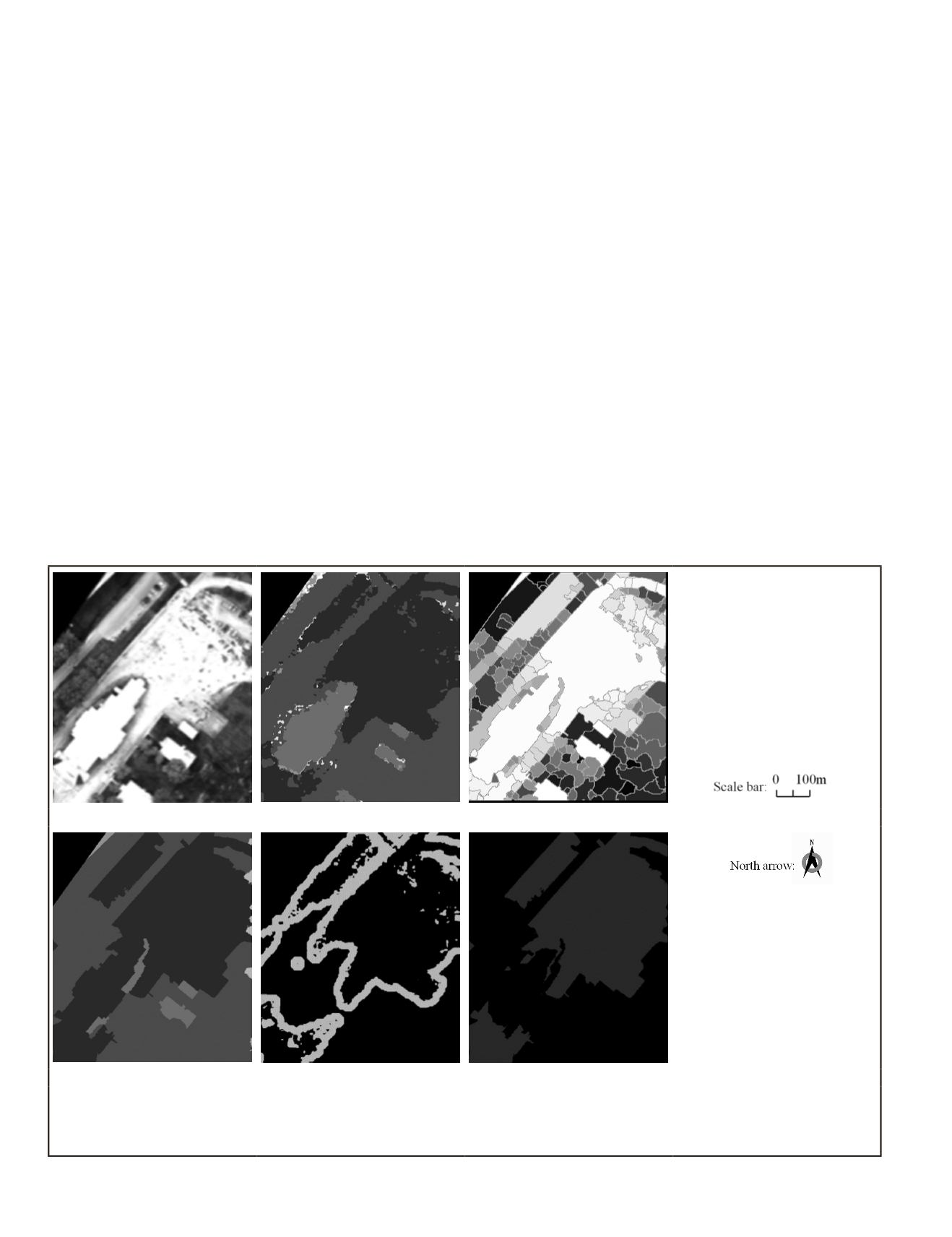
Figure 7b, the aforementioned
OOIFA
strategy misclassifies the
concrete roof class as roads, which is caused by the under-
segmented blocks in Figure 7c. Due to the scene complexity,
it is difficult to determine a suitable segmentation scale, and
even a multi-scale segmentation method may not fully ad-
dress this problem. In this paper, the fine separability and the
homogeneity of the road areas in the
TI-HSI
data are again uti-
lized to deal with the problem from another perspective. It is
believed that heat diffusion only affects adjacent pixels, and
the morphological dilation operation is conducted with road
pixels of the
TI-HSI
classification map. Pixels combined with
their dilation-related ones comprise the so-called “confidence
region,” and are labeled as potential roads, as shown in Fig-
ure 7e. In view of this, only pixels located in the confidence
region accept the labeling correction made by the
OOIFA
, as
shown in Figure 7f. Finally, the concept that the road regions
are elongated areas with connected components is utilized for
pruning, to generate the final road map (Maurya
et al.
, 2011).
Classification of Other Classes
For the remaining classes, we focus on the fine spatial resolu-
tion
VIS
data. However, the gaps in the
VIS
data may lead to
inaccurate spatial feature extraction. Thus, this procedure
consists of two components: (a) classification by stacked
multi-feature vectors; and (b) post-classification.
For
VHSR
imagery, the spatial features are valuable informa-
tion for image interpretation (Li
et al.
, 2014). In this work,
four meaningful morphological attribute profiles (Dalla Mura
et al.
, 2010), i.e., area, standard deviation (
SD
), diagonal box
(
DB
), and moment of inertia (
MI
), along with the gray level
co-occurrence matrix (
GLCM
) feature (Huang and Zhang, 2013)
and the spectral feature, are merged in a vector stacking (
VS
)
manner (Li
et al.
, 2014) for the classification. The selection
of the parameter set for the above spatial features depends on
the type of images and the application and task being dealt
with. For the study in this paper, we first extract the profiles
with the parameters in a large range, then compute the deriva-
tive of the profile, and pick out those containing meaningful
spatial structure. Recently, some automatic methods for the
selection of these spatial criteria have been proposed (Ghami-
si
et al.
, 2015). Among the various classifiers, linear
SVM
(Fan
et al.
, 2008) is efficient and effective enough to deal with
such a task with a large training sample set. To analyze the
study area, the parameters of linear
SVM
were automatically
determined by five-fold cross-validation (Li
et al.
, 2014) from
a reasonable range. After the classification, the segmentation
map of the
VIS
data is utilized as an object-based decision fu-
sion step (Sugg
et al.
, 2014) to conduct the post-classification
process. The selection of the parameter set in the mean-shift
segmentation procedure depends on the spectral and spatial
resolutions of the image and the terrain complexity within the
scene. For the study area, we set the spectral scale as 17, the
spatial scale as 15, and the smallest block size as 200 pixels.
Results and Discussion
Experimental Setting
Labeled samples were provided by the
IADF
2014 commit-
tee, as visually shown in Figure 1c, and were used for the
(a)
(b)
(c)
(d)
(e)
(f)
Figure 7. Illustration of the road extraction procedure within a sub-region of the scene: (a) The red band of the VIS dataset; (b) the TI-HSI
classification map; (c) the segmentation result and its boundaries in the VIS domain, with each grayscale value associated with the seg-
mentation parcel index; (d) the OOIFA result with the procedure described in the second Section; (e) the highlighted confidence regions,
along with pixels labeled as roads in (b); and (f) the final road map after refinement.
906
December 2015
PHOTOGRAMMETRIC ENGINEERING & REMOTE SENSING


